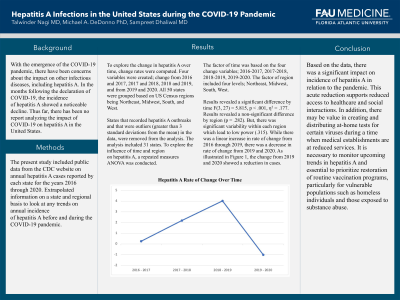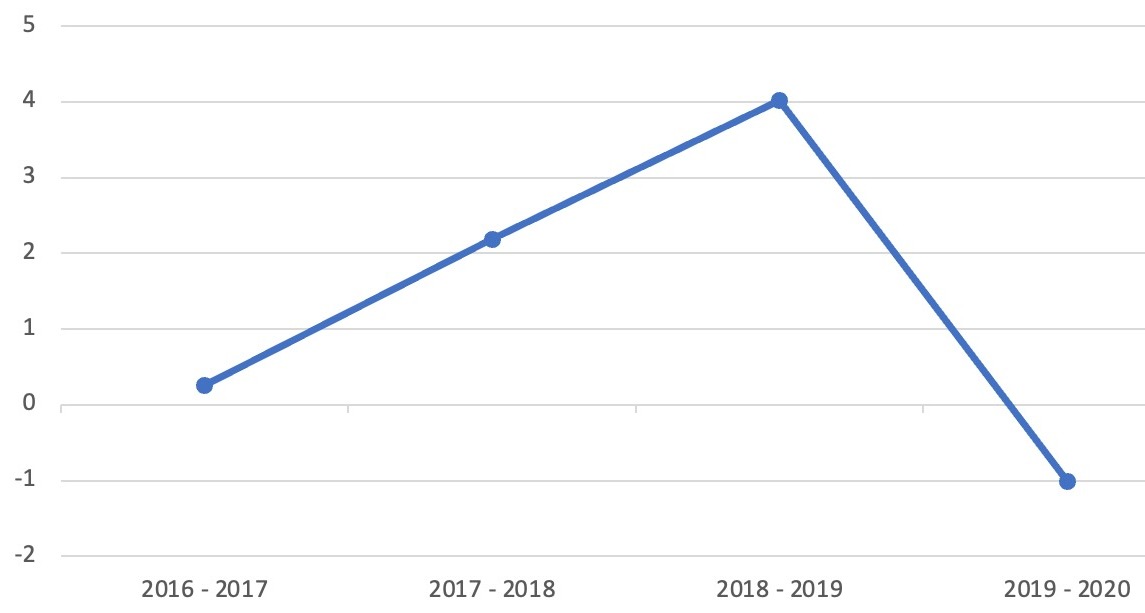Tuesday Poster Session
Category: Liver
P3836 - Hepatitis A Infections in the United States During the COVID-19 Pandemic
Tuesday, October 24, 2023
10:30 AM - 4:00 PM PT
Location: Exhibit Hall

Has Audio

Talwinder Nagi, MD
Florida Atlantic University Charles E. Schmidt College of Medicine
Boca Raton, FL
Presenting Author(s)
Talwinder Nagi, MD1, Michael A.. DeDonno, PhD2, Sampreet Dhaliwal, MD3
1Florida Atlantic University Charles E. Schmidt College of Medicine, Boca Raton, FL; 2Florida Atlantic University, Boca Raton, FL; 3McLaren Oakland, Pontiac, MI
Introduction: With the emergence of the COVID-19 pandemic, there have been concerns about the impact on other infectious diseases, including hepatitis A. In the months following the declaration of COVID-19, the incidence of hepatitis A showed a noticeable decline. Thus far, there has been no report analyzing the impact of COVID-19 on hepatitis A in the United States.
Methods: The present study included public data from the CDC website on annual hepatitis A cases reported by each state for the years 2016 through 2020. Extrapolated information on a state and regional basis to look at any trends on annual incidence of hepatitis A before and during the COVID-19 pandemic.
Results: To explore the change in hepatitis A over time, change rates were computed. Four variables were created; change from 2016 and 2017, 2017 and 2018, 2018 and 2019, and from 2019 and 2020. All 50 states were grouped based on US Census regions being Northeast, Midwest, South, and West. States that recorded hepatitis A outbreaks and that were outliers (greater than 3 standard deviations from the mean) in the data, were removed from the analysis. The analysis included 31 states. To explore the influence of time and region on hepatitis A, a repeated measures ANOVA was conducted. The factor of time was based on the four change variables; 2016-2017, 2017-2018, 2018-2019, 2019-2020. The factor of region included four levels; Northeast, Midwest, South, West. Results revealed a significant difference by time F(3, 27) = 5.815, p < .001, η2 = .177. Results revealed a non-significant difference by region (p = .282). But, there was significant variability within each region which lead to low power (.315). While there was a linear increase in rate of change from 2016 through 2019, there was a decrease in rate of change from 2019 and 2020. As illustrated in Figure 1, the change from 2019 and 2020 showed a reduction in cases.
Discussion: Based on the data, there was a significant impact on incidence of hepatitis A in relation to the pandemic. This acute reduction supports reduced access to healthcare and social interactions. In addition, there may be value in creating and distributing at-home tests for certain viruses during a time when medical establishments are at reduced services. It is necessary to monitor upcoming trends in hepatitis A and essential to prioritize restoration of routine vaccination programs, particularly for vulnerable populations such as homeless individuals and those exposed to substance abuse.

Disclosures:
Talwinder Nagi, MD1, Michael A.. DeDonno, PhD2, Sampreet Dhaliwal, MD3. P3836 - Hepatitis A Infections in the United States During the COVID-19 Pandemic, ACG 2023 Annual Scientific Meeting Abstracts. Vancouver, BC, Canada: American College of Gastroenterology.
1Florida Atlantic University Charles E. Schmidt College of Medicine, Boca Raton, FL; 2Florida Atlantic University, Boca Raton, FL; 3McLaren Oakland, Pontiac, MI
Introduction: With the emergence of the COVID-19 pandemic, there have been concerns about the impact on other infectious diseases, including hepatitis A. In the months following the declaration of COVID-19, the incidence of hepatitis A showed a noticeable decline. Thus far, there has been no report analyzing the impact of COVID-19 on hepatitis A in the United States.
Methods: The present study included public data from the CDC website on annual hepatitis A cases reported by each state for the years 2016 through 2020. Extrapolated information on a state and regional basis to look at any trends on annual incidence of hepatitis A before and during the COVID-19 pandemic.
Results: To explore the change in hepatitis A over time, change rates were computed. Four variables were created; change from 2016 and 2017, 2017 and 2018, 2018 and 2019, and from 2019 and 2020. All 50 states were grouped based on US Census regions being Northeast, Midwest, South, and West. States that recorded hepatitis A outbreaks and that were outliers (greater than 3 standard deviations from the mean) in the data, were removed from the analysis. The analysis included 31 states. To explore the influence of time and region on hepatitis A, a repeated measures ANOVA was conducted. The factor of time was based on the four change variables; 2016-2017, 2017-2018, 2018-2019, 2019-2020. The factor of region included four levels; Northeast, Midwest, South, West. Results revealed a significant difference by time F(3, 27) = 5.815, p < .001, η2 = .177. Results revealed a non-significant difference by region (p = .282). But, there was significant variability within each region which lead to low power (.315). While there was a linear increase in rate of change from 2016 through 2019, there was a decrease in rate of change from 2019 and 2020. As illustrated in Figure 1, the change from 2019 and 2020 showed a reduction in cases.
Discussion: Based on the data, there was a significant impact on incidence of hepatitis A in relation to the pandemic. This acute reduction supports reduced access to healthcare and social interactions. In addition, there may be value in creating and distributing at-home tests for certain viruses during a time when medical establishments are at reduced services. It is necessary to monitor upcoming trends in hepatitis A and essential to prioritize restoration of routine vaccination programs, particularly for vulnerable populations such as homeless individuals and those exposed to substance abuse.

Figure: Hepatitis A Rate of Change Over Time
Disclosures:
Talwinder Nagi indicated no relevant financial relationships.
Michael DeDonno indicated no relevant financial relationships.
Sampreet Dhaliwal indicated no relevant financial relationships.
Talwinder Nagi, MD1, Michael A.. DeDonno, PhD2, Sampreet Dhaliwal, MD3. P3836 - Hepatitis A Infections in the United States During the COVID-19 Pandemic, ACG 2023 Annual Scientific Meeting Abstracts. Vancouver, BC, Canada: American College of Gastroenterology.
